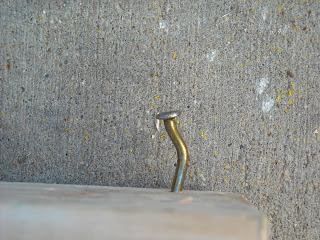
 The Dirtbag brigade and the earthen greenhouse was a great experiment; we learned a lot along the way and we had a lot of good times as well.
The Dirtbag brigade and the earthen greenhouse was a great experiment; we learned a lot along the way and we had a lot of good times as well.Since my last post, father winter hit Saginaw and our little greenhouse didn't trap any heat or sun rays. The new roof held up well through the winter weather, however. Luckily, I didn't have the time to replant the buckets--they would've froze. We kept the temperature log and it reported very cold temperatures in the greenhouse, so we didn't have a lot of experimental data for the project, but hey, we went out with a BANG.

I checked on the greenhouse last Sunday and, to my surprise, found about 6-8 inches of green, half frozen water inside. I'm not sure how that much water entered as we didn't have a lot of precipitation during the week before and I had checked it the previous Sunday and it was pretty dry.
I thought maybe groundwater was seeping in because the hole is over 4 feet deep. Dr. Thomas thought maybe because the nearby corn field was recently cut, the groundwater level became higher; which makes sense.
 Anyways, I had to devise a way to retrieve the thermometer which was hanging in the center by a string. I was going to just tough it out and step in the half-frozen water but I like to avoid hypothermia at all costs. I decided to make a bridge with the dirtbags, that worked well and I felt a little like Indiana Jones for a bit.
Anyways, I had to devise a way to retrieve the thermometer which was hanging in the center by a string. I was going to just tough it out and step in the half-frozen water but I like to avoid hypothermia at all costs. I decided to make a bridge with the dirtbags, that worked well and I felt a little like Indiana Jones for a bit.Although the greenhouse didn't thrive well, it was still a good experiment.
Alyssa and I learned a lot from it:
- First and I think most importantly, we learned how to make quick decisions on our own without the direct guidance of an instructor...It truly was an independent study.
- We learned how to make our own experiment, what the most important factors to measure with the plants (plant size, plant count, etc.) (I didn't get to do a lot of that because the experiment was ruined during the first spell of mother nature's destructive fist.)
- We learned how to improvise which is important when something is unplanned (like our roof collapse.)
- We learned a lot about building roofs and our patience. Carpentry, haha.
- And we also learned that this model of farming is probably not something an urban community would take the time to implement. It takes a lot of manual labor and it simply didn't work like the huge earthen greenhouses in China do.
- Also, Taco Bell is real tasty after filling dirtbags at midnight with Dan and Alyssa.
I look forward to more urban farming project in the future. Adios.

 bits and we are both pretty incompetent when it comes to drills (we had the drill on reverse for a good 10 minutes.) After some time we finished the second square. at this point we felt pretty defeated so we decided to wait for another student (Dan) to help us stretch the plastic.
bits and we are both pretty incompetent when it comes to drills (we had the drill on reverse for a good 10 minutes.) After some time we finished the second square. at this point we felt pretty defeated so we decided to wait for another student (Dan) to help us stretch the plastic.





 We're on week two of the earthen greenhouse with global buckets study.
We're on week two of the earthen greenhouse with global buckets study. As of now, it appears that the spinach is beating the basil in a growing race. Almost all of the Spinach plants have sprouts and Basil isn't too far behind. The Spinach buckets have grown considerably since last week. The Basil buckets aren't growing as quickly.
As of now, it appears that the spinach is beating the basil in a growing race. Almost all of the Spinach plants have sprouts and Basil isn't too far behind. The Spinach buckets have grown considerably since last week. The Basil buckets aren't growing as quickly.











.jpg)










